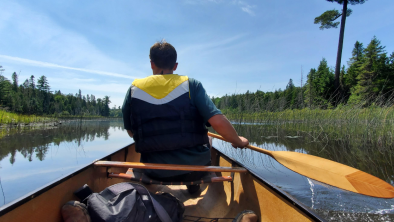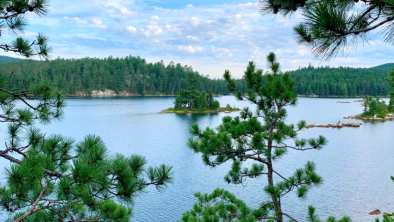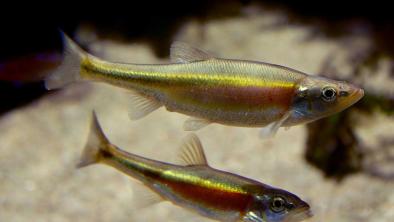Expert report says Ontario needs a strategic approach to expanding protected places
Wilderness Committee
Groups urge new Ontario environment minister to act on recommendations of government-appointed Protected Areas Working Group
TORONTO / WENDAT, ANISHNABEG, HAUDENOSAUNEE, CHIPPEWA AND MISSISSAUGAS OF THE CREDIT TRADITIONAL TERRITORIES — Ontario has fallen behind other provinces and territories in expanding its protected areas and needs a comprehensive strategy with funding attached, according to an expert report submitted to the provincial government.
The government established the Protected Areas Working Group in 2021 to “identify opportunities to protect and conserve more natural areas." The group provided recommendations to the Minister of Environment, Conservation and Parks in a 2021 report that was not made public until two years later through a Freedom of Information request by the Wilderness Committee in June 2023.
Take action: Ontario needs a strategic plan to grow protected places
Now, 124 organizations are urging the newly appointed Minister of Environment, Conservation and Parks, Andrea Khanjin, to follow through on the working group’s key recommendations. These include:
- Committing to protecting 30 per cent of the province’s lands and waters by 2030,
- Working with First Nations, the public, municipalities and conservation organizations to immediately implement a strategy to achieve the target which was endorsed by 196 countries, including Canada, at the COP15 conference in December 2022.
According to polling commissioned by the expert working group, more than 86 per cent of Ontarians support the expansion of parks and protected areas, and the majority would be willing to pay higher taxes to support this work.
The report states that the current overall amount of protected land in Ontario — including national and provincial parks, conservation reserves and lands held by private land trusts — amounts to less than 11 per cent, putting Ontario eighth among provinces and territories. The working group also found that “protected and conserved area work has been a low, under-resourced priority within the provincial government.” They went on to state that Ontario only increased protected lands by 3,007 hectares from 2016 to 2021, compared to 20 million hectares across the rest of the country.
Quotes:
“There is a groundswell of support for designing, building and implementing new protected areas in Ontario. Indigenous communities and non-profit organizations have been taking the lead in identifying potential candidate protected areas, including Indigenous-led conservation proposals and grassroots efforts. There is no time like the present to take ambitious steps towards expanding and strengthening protected and conserved areas in Ontario.” – Katie Krelove, Ontario Campaigner for the Wilderness Committee
“Faced as we are with unprecedented and accelerating levels of biodiversity loss and ever spiralling climate change impacts, the need to expand protected and conserved areas in Ontario has never been more urgent. They offer an immediate, tangible approach to conserving the plants, animals and ecosystems that sustain us and to enhancing our resilience to climate change.” – Dr. Anne Bell, Director of Conservation and Education, Ontario Nature
“It is still possible for Ontario to play a leadership role in meeting the target of protecting 30 percent of our lands and waters by 2030 – the target embraced by Canada and other parties to the United Nations Convention on Biological Diversity in Montreal last December. Doing so will require a strong government mandate, cooperation across government ministries, the recognition of Indigenous land governance rights and responsibilities, and collaboration with conservation experts. A clear and transparent strategy with timelines and objectives will be essential, as outlined in the working group report.” – Rachel Plotkin, Boreal Project Manager, David Suzuki Foundation
-30-
For more information or to arrange an interview, contact:
Katie Krelove, Wilderness Committee, katie@wildernesscommittee.org, 647-208-4026
John Hassell, Ontario Nature, johnh@ontarionature.org, 416-786-2171
Kate Kourtsidis, Communications Specialist, David Suzuki Foundation kkourtsidis@davidsuzuki.org 613-806-8184
Fancy meeting you here at the end of this article! Care to hang out together for a few more sentences?
The campaign you just read about is one of about 20 we’re actively working on at any given time. And the person who wrote this article is the same campaigner who’s asking you to take action, who’s calling on our legislators to make changes and who’s in the field to bring you photos, videos and stories documenting this issue.
Did you notice how we’re a bit distinct, that we’re not afraid to call out the industries or governments that threaten what’s wild? Unlike other groups, we’re almost 100 per cent* “people powered.” Individuals like you who care give what they can, when they can. No corporate or government funding restricts our strategies, our actions or our voice. That’s how we stay a lean, nimble and unequivocally relentless voice for wilderness, wildlife and the climate. That’s why we’d love it if you’d consider joining us by making a monthly donation to the Wilderness Committee today.
LET'S MAKE A DIFFERENCE TOGETHER
We’ve already established you like to read to the end, so here’s the fine print. It’s 96 per cent of our funding which comes from individuals like you and me. About four per cent of our total funding comes from a few grants from foundations. Every gift — no matter the size — has an impact and powers our work for nature.


